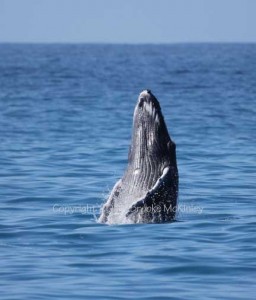Aloha,
Researchers think that the gestation period for a Humpback is around 11 months, which means the calves we’re seeing this year were conceived last year…and on Tuesday, we got to see both aspects of the life cycle, Our Tuesday Wake up With the Whales Cruise began with Mom and calf right outside of the bay. They stayed with us for about 15  minutes, and then we saw a competitive pod starting up, so we left our Mom and calf and headed out to see what was going on. There were some really aggressive whales in this pod, banging into each other, head lunging and pec slapping. It was difficult to see if there was a female being chased, or if this was just a group of males fighting amongst each other. We were fortunate enough to watch this pod for over an hour before we had to leave them and return to the bay.On the 10:00 Whale Watch from Kawaihae, a Mom/Calf pod spent some time with us, followed by a different Mom/Baby/Escort pod. Baby breached repeatedly (and adorably). And on our Whales and Cocktails Cruise, we also got to watch two different Mom/Calf pods. The first was accompanied by 2 escorts, and the second pod was accompanied by 3 escorts. There was a lot of competition going on between the males in the second group, which got baby excited. That little guy kept breaching and breaching and breaching just about 50 yards from our idling boat.
minutes, and then we saw a competitive pod starting up, so we left our Mom and calf and headed out to see what was going on. There were some really aggressive whales in this pod, banging into each other, head lunging and pec slapping. It was difficult to see if there was a female being chased, or if this was just a group of males fighting amongst each other. We were fortunate enough to watch this pod for over an hour before we had to leave them and return to the bay.On the 10:00 Whale Watch from Kawaihae, a Mom/Calf pod spent some time with us, followed by a different Mom/Baby/Escort pod. Baby breached repeatedly (and adorably). And on our Whales and Cocktails Cruise, we also got to watch two different Mom/Calf pods. The first was accompanied by 2 escorts, and the second pod was accompanied by 3 escorts. There was a lot of competition going on between the males in the second group, which got baby excited. That little guy kept breaching and breaching and breaching just about 50 yards from our idling boat.
 minutes, and then we saw a competitive pod starting up, so we left our Mom and calf and headed out to see what was going on. There were some really aggressive whales in this pod, banging into each other, head lunging and pec slapping. It was difficult to see if there was a female being chased, or if this was just a group of males fighting amongst each other. We were fortunate enough to watch this pod for over an hour before we had to leave them and return to the bay.On the 10:00 Whale Watch from Kawaihae, a Mom/Calf pod spent some time with us, followed by a different Mom/Baby/Escort pod. Baby breached repeatedly (and adorably). And on our Whales and Cocktails Cruise, we also got to watch two different Mom/Calf pods. The first was accompanied by 2 escorts, and the second pod was accompanied by 3 escorts. There was a lot of competition going on between the males in the second group, which got baby excited. That little guy kept breaching and breaching and breaching just about 50 yards from our idling boat.
minutes, and then we saw a competitive pod starting up, so we left our Mom and calf and headed out to see what was going on. There were some really aggressive whales in this pod, banging into each other, head lunging and pec slapping. It was difficult to see if there was a female being chased, or if this was just a group of males fighting amongst each other. We were fortunate enough to watch this pod for over an hour before we had to leave them and return to the bay.On the 10:00 Whale Watch from Kawaihae, a Mom/Calf pod spent some time with us, followed by a different Mom/Baby/Escort pod. Baby breached repeatedly (and adorably). And on our Whales and Cocktails Cruise, we also got to watch two different Mom/Calf pods. The first was accompanied by 2 escorts, and the second pod was accompanied by 3 escorts. There was a lot of competition going on between the males in the second group, which got baby excited. That little guy kept breaching and breaching and breaching just about 50 yards from our idling boat.Mahalo,
Claire
Captain Claire’s Humpback Fact of the Day: Not all whaling activity occurred during the “golden age of whaling” at the beginning of the 19th century. Based on catch records corrected for illegal Soviet whaling, a total of more than 200,000 Humpback Whales were killed in the Southern Hemisphere from 1904 to 1980. Also, Illegal Soviet takes of 25,000 Humpback Whales in two seasons (1959/60 and 1960/61) precipitated a population crash and the closure of land stations in Australia and New Zealand.
